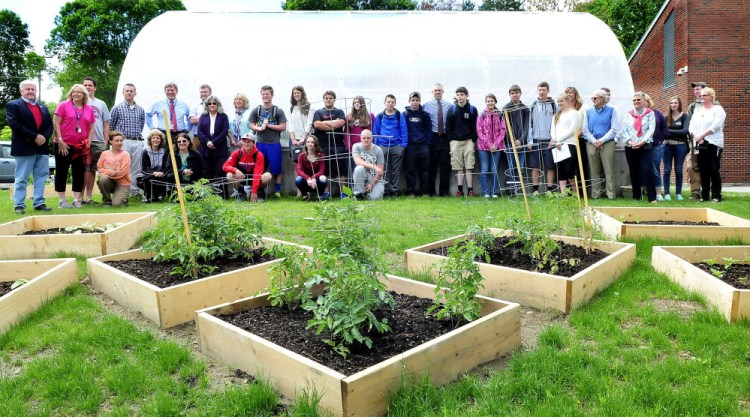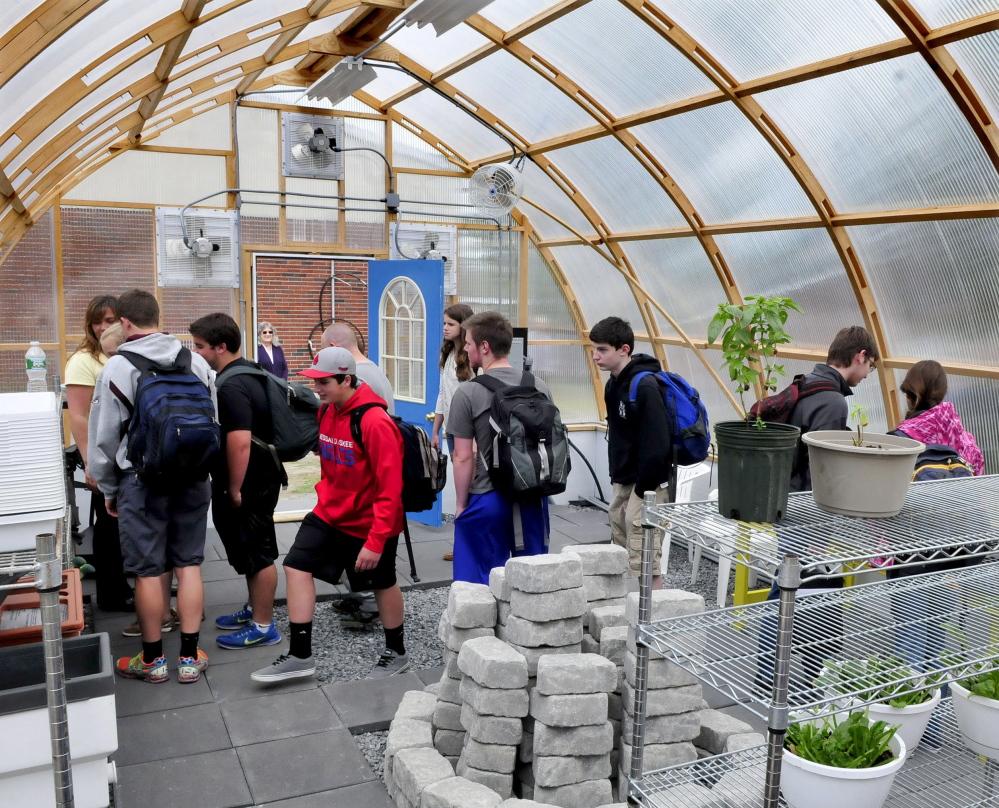OAKLAND — After a full year of preparation, Messalonskee High School officially opened its greenhouse in a ribbon-cutting ceremony Wednesday afternoon.
About two dozen students, teachers, administrators and guests involved in the project gathered around the greenhouse for photos. At a reception inside, visitors tasted spinach grown by high school students.
“I think it’s going to be a great resource for the school,” said Beth Prelgovisk, a physical health and first aid teacher who helped direct the student-led effort to build the greenhouse.
It’s clear that the school wants the greenhouse to last. The structure, 18 feet wide by 28 feet long, is coated in plastic sheeting with polycarbonate siding and has a concrete foundation with a quarter-inch crushed gravel base. It also has a high-powered, three-fan ventilation system.
The greenhouse will become the stage of a plant biology course set to start next year and will serve as a workshop for other science classes. Fruit and vegetables grown in the greenhouse will supplement cafeteria meals and local food pantries.
The idea for a school greenhouse came from Kristy Prelgovisk, a graduating senior this year. Last year, she and her friends decided they wanted to see more fresh food in the school’s cafeteria, and they started thinking about how to make it a reality, said Beth Prelgovisk, Kristy’s mother. Students in the Garden Club started researching grants to pay for the project and, working with administrators, came up with about $15,000 in funding.
“From there, it just seemed to snowball,” said Beth Prelgovisk, who’s the Garden Club adviser.
As the project picked up steam, it gained more attention and grant opportunities, according to Prelgovisk. Community volunteers and businesses also got involved, donating time, money and material to the effort.
The project gained so much support because it was student-led, Prelgovisk said.
“They were the ones who were so involved with getting this organized,” she said of her daughter and her friends.
Seedlings planted in the greenhouse will be placed in the raised beds nearby. The 11 beds are arranged in the shape of an M for Messalonskee that can be seen from the high school’s lower parking lot.
The tomatoes, peppers, squash and other produce grown in the gardens will be donated to the local summer meals program and the local food pantry, Prelgovisk said. Next year, the hope is to introduce student-grown vegetables in the school’s cafeteria.
But the greenhouse also will be used as an instruction space.
“It’s not just going to be me and my group who are using this. It’s going to be a variety of teachers in our school,” Prelgovisk said.
Starting next year, Bryan Quigly, a Messalonskee High School science teacher, will offer a dual-enrollment plant biology course with Kennebec Valley Community College so high school students can earn college credits.
Quigly sees other opportunities for the new resource. The school intends to add a water feature and try aquaponic cultivation, and Quigly wants to grow plants that students might not come across in Maine.
But a central focus for Quigly is the importance of connecting students to plants as part of the food system.
“A really big thing for the future is food science,” Quigly said, “working with these plants and finding new solutions to problems that we’re going to possibly run into.”
While the greenhouse is a high-profile project, local food is becoming a focus for the entire Regional School Unit 18 school district. Many schools in the district have gardens, and Messalonskee Middle School recently installed hoop houses. Late last year, RSU 18 was selected to receive a $44,000 Farm to School grant from the U.S. Department of Agriculture to fund the development of a long-term plan to bring more local food into school cafeterias and connect students with regional agriculture. An energetic working group meets frequently to pull together its proposal.
“Seeing where your food comes from really gives you an understanding what goes through getting that tomato to the grocery store,” Quigly said. “You gain a deeper appreciation for everything that goes into food production.”
Businesses that donated time and materials to the project included Mid-Maine Marine, Rick Labbe Construction, Perry Electric, Gagne and Sons construction, Blake Family Hardware, Fabian Oil Co., Waterville Rotary and Hammond Lumber.
Peter McGuire — 861-9239
Twitter: PeteL_McGuire
Send questions/comments to the editors.




